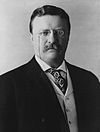Paul Morton (politician)
This article includes a list of references, related reading, or external links, but its sources remain unclear because it lacks inline citations. (February 2014) |
Paul Morton | |
|---|---|
 | |
| 36th United States Secretary of the Navy | |
| In office July 1, 1904 – June 30, 1905 | |
| President | Theodore Roosevelt |
| Preceded by | William H. Moody |
| Succeeded by | Charles J. Bonaparte |
| Personal details | |
| Born | May 22, 1857 Detroit, Michigan, U.S. |
| Died | February 19, 1919 (aged 61) New York City, New York, U.S. |
| Political party | Republican |
| Profession | Politician, Businessman |
Paul Morton (May 22, 1857 – February 19, 1911) was a U.S. businessman, and served as the 36th Secretary of the Navy under Theodore Roosevelt.
Biography
He served as the U.S. Secretary of the Navy between 1904 and 1905. Previous to this, he had been vice president of the Santa Fe Railroad. When it came to light that the Santa Fe had given illegal rebates under Morton, he was forced out of the cabinet to avoid scandal, though Roosevelt maintained that Morton himself was unaware of the improprieties. After leaving government service, Morton was President of Equitable Life Assurance Society.
Born in Detroit, Michigan, and growing up in Nebraska City, Nebraska, he was the younger brother of Joy Morton, founder of Morton Salt, and the son of Julius Sterling Morton, who had served as Secretary of Agriculture under President Grover Cleveland. Though his father was a "Bourbon" (i.e. conservative) Democrat, Paul Morton was a Progressive Republican. This shift of party by father/son cabinet secretaries is paralleled by that of Henry Cantwell Wallace, who served as a Progressive Republican Secretary of Agriculture under Harding and Coolidge, and his son Henry A. Wallace who served in the same office as a Democrat under Franklin D. Roosevelt.
George Burroughs Torrey painted a portrait of him.
Sources
- The Political Graveyard
- Tone's Fighting Ships
- Dictionary of American Biography, Under the Auspices of the American Council of Learned Societies, C. Scribner’s Sons, New York City, 1928.




